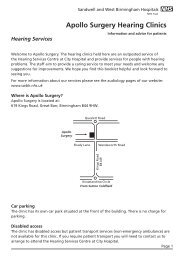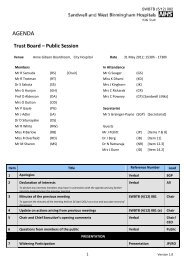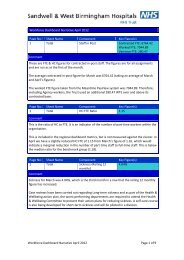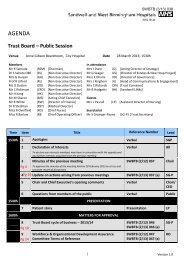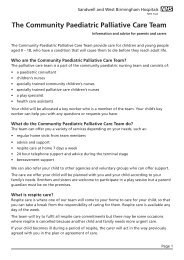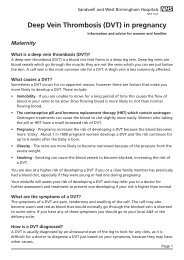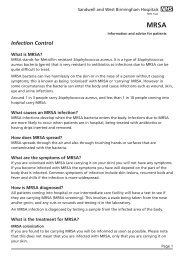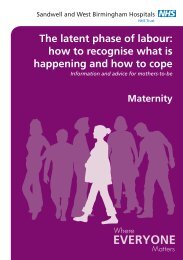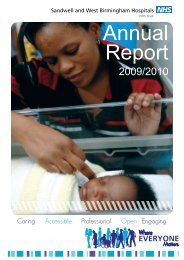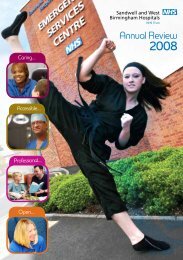January 2012 - Sandwell & West Birmingham Hospitals
January 2012 - Sandwell & West Birmingham Hospitals
January 2012 - Sandwell & West Birmingham Hospitals
Create successful ePaper yourself
Turn your PDF publications into a flip-book with our unique Google optimized e-Paper software.
SWBTB (1/12) 286 (a)<br />
The options appraisal indicated that options 3 and 6 are the two highest scoring options.<br />
Therefore options 3 and 6 will be presented for the formal consultation process. These<br />
options will be subdivided into options 3a and 3b, and 6a and 6b to include the possibility of<br />
configuring acute services in each option at either hospital (City or <strong>Sandwell</strong>).<br />
7.2 Short Listed Options<br />
Option 3a<br />
This is a single site model with all stroke and TIA facilities and services located at City<br />
Hospital.<br />
This includes all hyper-acute emergency care and acute care, rehabilitation wards, Imaging<br />
and Out -patient services, TIA services. Patients who arrive in the Accident and Emergency<br />
Department (A&E) at <strong>Sandwell</strong> Hospital, who are suspected as having a stroke or TIA would<br />
be transferred to City Hospital for in-patient treatment and/or specialist out-patient care.<br />
This option provides at City Hospital:<br />
A single Hyper-Acute Stroke Unit with a 24/7 service and incorporating neurology<br />
beds within the hyper-acute area.<br />
Initially patients would access the Hyper- Acute Stroke Unit from ED but the plan<br />
would be for the Unit to take direct admissions within 12- 24 months (allowing a two<br />
stage approach for the implementation of this model).<br />
Short and long stay rehabilitation would be provided in a dedicated stroke<br />
rehabilitation ward located at the same site near to the hyper-acute unit.<br />
There would be a telemedicine link from the Emergency Department (ED) to the<br />
hyper-acute facility.<br />
In addition there would be early supportive discharge (ESD) assessment and<br />
intervention available on site from the earliest opportunity.<br />
All TIA patients would be managed on an outpatient basis. TIA services would be<br />
enhanced via inclusion of a telemedicine approach from the Hyper-Acute Unit to ED.<br />
Option 3b (As above but at <strong>Sandwell</strong> Hospital)<br />
This is a single site model with all stroke and TIA facilities and services located at<br />
<strong>Sandwell</strong> Hospital.<br />
Option 6a<br />
Provides a two site model with one hyper-acute stroke unit and high risk TIA services<br />
located at City Hospital. Rehabilitation services would be provided at both City and<br />
<strong>Sandwell</strong> <strong>Hospitals</strong>.<br />
This option provides:<br />
A single Hyper-Acute Stroke Unit at City Hospital with a 24/7 service and<br />
incorporating neurology beds within the hyper-acute area.<br />
Initially patients would access the Hyper- Acute Stroke Unit from ED but the plan<br />
would be for the Unit to take direct admissions within 12- 24 months (allowing a two<br />
stage approach for the implementation of this model).<br />
Rehabilitation units which provide both short and long stay rehabilitation and include<br />
dedicated stroke palliative care services as part of continuing care would be provided<br />
on both City and <strong>Sandwell</strong> <strong>Hospitals</strong> as would early supportive discharge services.<br />
High risk TIA service would be provided 7 days per week at City Hospital alongside<br />
the Hyper-Acute Stroke Unit. This service would see all high risk patients and some<br />
low risks patients depending on daily capacity. In addition there would be dedicated<br />
low risk TIA slots within general OPD to ensure capacity at all times to enable the<br />
15




